In one of our recent Visualising War podcast episodes, Alice interviewed award-winning artist Kathryn Brimblecombe-Fox. Kathryn started painting as a child, selling her first piece of art at just 14 years old, winning her first major art competition at 16, and holding her first exhibition at 17. She has since exhibited not just in her native Australia but in Abu Dhabi, Dubai, South Korea, Norway London and New York. Her art takes inspiration from nature and the cosmos, and in recent years she has focused particularly on the existential threats posed to us and our world by emerging technologies. This has led her to look at military technologies – something which she is exploring academically as well as artistically through a PhD.
Kathryn uses the powerful analogue medium of painting to ask huge questions about new media, especially those that use the electromagnetic spectrum: a natural phenomenon which we can’t see with the naked eye but which many different organisations are using for scientific, commercial or military purposes. Fundamentally, her art is a powerful exercise in visualisation, inviting us to look deep into the past as well as into the future, and to pay attention to phenomena that threaten our landscape and human existence. In particular, she focuses attention on the ‘everywhere war’: the increasing blurring of military and civilian technologies and activities, a development which challenges our long-established habits of visualising (and separating) ‘war’ and ‘peace’.
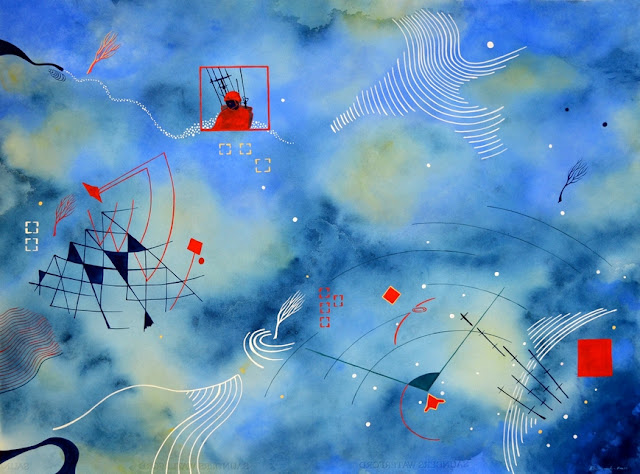
In the podcast, Kathryn described her approach as ‘imaginational metaveillance’ – a term she has come up with to capture the critical, analytical observations that her art performs by taking us to places we can only go in our imaginations and getting us to look critically at things we cannot physically see. In her paintings, she invites us to fly, so that we can look down from above earth’s atmosphere like a scoping drone – or a bird, a speck of star dust, a pilot in an aircraft, a drone, a moon beam, a solar ray, Voyager 1 or 2, an intergalactic space traveller, or even a multiple of these! – seeing natural clouds but also online/digital ‘clouds’ that swirl everywhere, and the invisible grids that criss-cross earth and sky, measuring our every move and harvesting our data.
Kathryn also explained why she uses age-old symbols like the Tree of Life to help viewers connect with the whole span of human history as they visualise future threats and possibilities, both military and civilian – or a combination of the two. We discussed her artistic style, which draws readers in with lots of colour and beautiful aesthetics, and also the responses which viewers often have to her art: most are enthusiastic, until they look closely and grasp its worrying ‘revelations’ about the threats that lurk in our present and future.
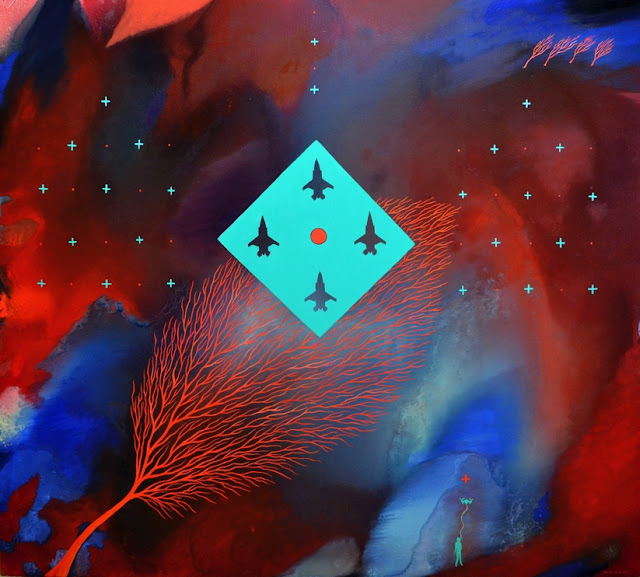
Future Memory Oil on linen 122 x 137 cm 2021 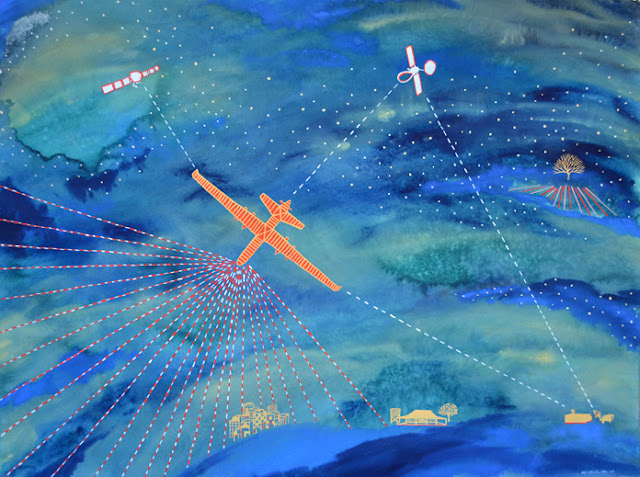
Not a Game Gouache and watercolour on paper 57 x 76.5 cm 2016
That got us talking about the impact which Kathryn wants to have with her art. Among other places, Kathryn has exhibited at the Australian Defence College, and she has enjoyed the many reflective conversations it has opened up with lots of different visitors. She believes that the critical and imaginative visions of past, present and future which art can prompt us to engage with have much to contribute to policy-making, strategy-making and futures thinking, and she describes her own work as a form of quiet activism, opening up dialogue and inviting people to engage with big questions.
Below are some of the artworks we talked about in the podcast. You can find more – and more of Kathryn’s analysis of them – on her blog.
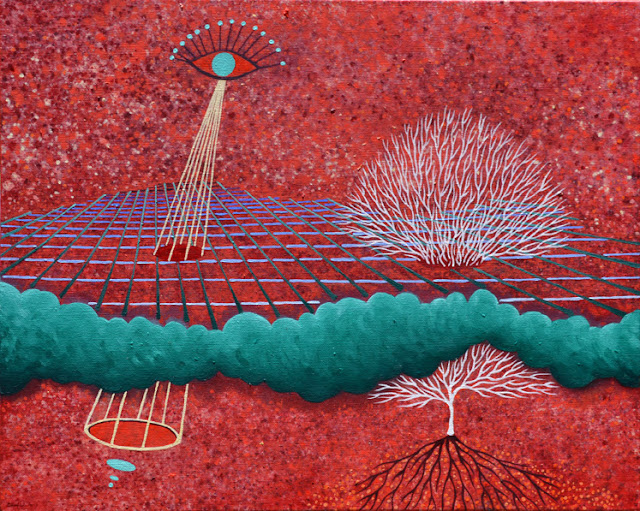
Follow Me, Says The Tree Oil on canvas 60 x 76 cm 2017 https://kathrynbrimblecombeart.blogspot.com/2018/01/follow-me-says-tree.html
Kathryn discusses this painting on her blog here:
“Follow Me, Says the Tree combines my interpretation of a tree-of-life with a few of my other interests. These include thinking about how landscape is mediated in the 21st century – the age of cyber and digital technologies, drones, perpetual war and the ‘everywhere war’. The tree-of-life is a symbol of life – for the existence of life. But, how is human existence affected by accelerating developments in technology, particularly surveillance technologies and weaponised [or weaponisable] technologies? In other words, those technologies that deploy scoping capabilities to monitor, surveil and target. SCOPING: I attempt to reveal invisible scoping signals, transmitted and received by airborne drones. I do this to demonstrate that landscape is insidiously mediated by new but unseen signal topographies. These new topographies not only mediate landscape, they also influence, to a greater or lesser extent, how humans operate and live in the landscape and environment. For example, in some places in the world – war and conflict zones – loitering airborne [often weaponised] drones create a persistent fear of the sky. This fear is fueled by a drone’s ability to quickly turn from monitoring and surveillance to scoping to target – for a kill. FALSE EYE – FALSE CLOUD: In Follow Me, Says the Tree I have depicted an eye painted in the sky. Its pupil in a shade of night vision green. It is an unblinking false eye, with ‘lashes’ that appear to be more like components from a computer circuit board. The signals that radiate from the eye penetrate through a surveillance net which is scaffolded by a night vision green CLOUD* – a false cloud. The eye is clearly not an eye, with all the connotations of human sight, insight, imagination, vision, dreaming, tears and laughter. The eye is a subterfuge – it is not an eye-in-the sky – it is a SCOPE-IN-THE-SKY. It targets its prey with a precision that is aided and abetted by persistent surveillance. TREE-OF-LIFE: However, what of the tree? It also penetrates the net of surveillance and the CLOUD, by reaching upwards towards the stars. It re-establishes perspective – the kind that can take humanity’s endeavours into interstellar space. The tree’s branching appearance contrasts with the clean lines of surveillance and targeting signals. Randomness, or seeming randomness, is presented as a complex decoy – but isn’t that just LIFE! The tree not only erupts through the surveillance net, it also send roots underground. Where there’s life there’s hope it seems to say. Follow me, and life and existence will be ok.”

Anomaly Detection Gouache and watercolour on paper 56 x 76 cm 2017 https://kathrynbrimblecombeart.blogspot.com/2017/03/anomaly-detection.html
Here’s what Kathryn has written about another of the paintings we discussed, Anomaly Detection: “The term anomaly detection is a technical one. It is an automatic system for detecting unusual behaviour, patterns or occurrences in, for example, live or stored data, such as film footage. Anomaly detection can allow preemptive actions. Regarding military drones the identification of anomalous behaviour, for example multiple vehicles moving at speed from different directions towards one destination, can trigger an alert for increased surveillance and readiness for potential attack. A drone’s wide area surveillance capabilities mean expansive areas can be surveilled, and sophisticated detection and recognition algorithms are employed as another layer of surveillance monitoring. In civilian arenas anomaly detection systems are useful for a variety of monitoring requirements that range from security to environmental protections and more.
In Anomaly Detection I have turned drone surveillance on its head. Here, I have painted the drones as if pixelated, as if a detection and recognition algorithm has detected the anomalous behaviour of three armed drones converging on the tree-of-life hovering at the center of the image. The viewer of the painting could be monitoring the drones from the ground, looking up – or – from the sky/space looking down. In this way the viewer becomes aware of the power of perspective, even in imagination.
COSMIC PERSPECTIVE: Cosmic perspectives implore us to seek distance, both close and far, as a way to examine ourselves and the planet. From vast distances it becomes obvious that planet Earth, despite discoveries of possible habitable exo-planets, is our only home for the foreseeable [and beyond] future. We need to look after the planet and ourselves. By exploring perspective and engaging with multiple perspectives maybe we’ll discover more anomalies that highlight risk in ways that trigger precautionary, preemptive, restorative and pro-actionary activities?”
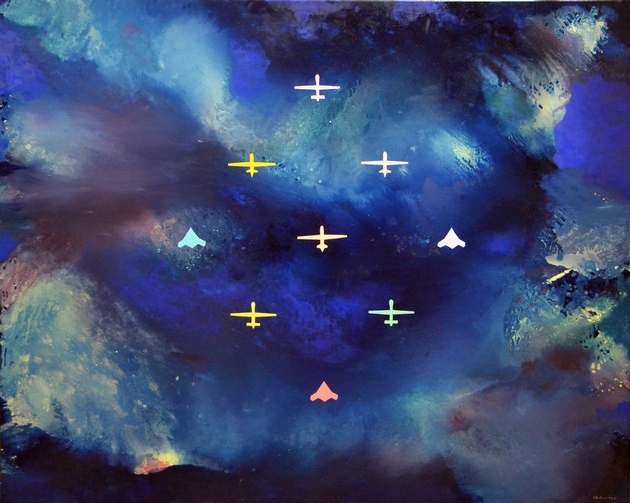
https://kathrynbrimblecombeart.blogspot.com/2020/05/drone-show.html
As Kathryn says on her blog, “Drone technology – civilian and militarised – needs our attention!” In her painting Drone Show, weaponise-able drones are seen in a formation, as if performing. As she explains, “There are three types of drones – Reapers, Predators and X47Cs. It’s like a parade of drones! I choose the word parade deliberately, its connection with military parades acting as a provocation.
Perspective and Imaginational Metaveillance: As with many of my paintings, the viewer could be below the drones looking up at a wild cosmic sky, or the viewer could be above the drones, looking down upon a turbulent but beautiful landscape. Once this play with perspective is realised, the viewer can ‘fly’, in imagination, soaring above, below and around the drones. I love to play with perspective by inviting viewers to ‘fly’. It turns a unique human kind of surveillance back onto the drones. I call this an act of ‘imaginational metaveillance’. It is uniquely human because it involves imagination – something machine learning and artificial intelligence are not capable of – yet. I argue that imagination, or a simulation of imagination, are capabilities no-one should aspire to enable an AI or an AGI with. If this is an aspiration then its more about creating an artificial human rather than an artificial intelligence.
Light Shows: I also called the painting Drone Show to reference displays of civilian drones programmed to perform mesmerising light shows. These kinds of performances are, for example, great substitutes for fireworks. Although the drones in these performances are pre-programmed they represent a basic form of drone swarming technology. A sophisticated drone swarm will have more autonomous functions – geo-locating, orienting, target identification and so on. While militarised drone swarming technology is still being developed in a number of countries, a drone swarm could, among other things, be armed, be used as a swarm of weapons, act as a surveillance net or scaffold signal transmission to other assets. Suddenly the idea of a ‘light show’ becomes more ominous.
Aesthetic Seduction: I have painted each of the drones in Drone Show withdifferent colours. I have painted the drones in a pattern, a diamond pattern. This pattern, the colours and the wild beauty of the landscape/skyscape draw the viewer closer. Once close, the drones becomes more apparent. Why are they there? I am using aesthetic seduction to create a shock, to garner attention and to stimulate questions about drone technology. A militarised drone’s function stands in sharp contrast to the beauty which is evident in the painting. This is a deliberate means of arresting the viewer’s attention. I know many people are critically interested in drone technology, but I have noticed that many others are either in awe or indifferent to it. Both awe and indifference are potentially dangerous. Awe and indifference are risks.”
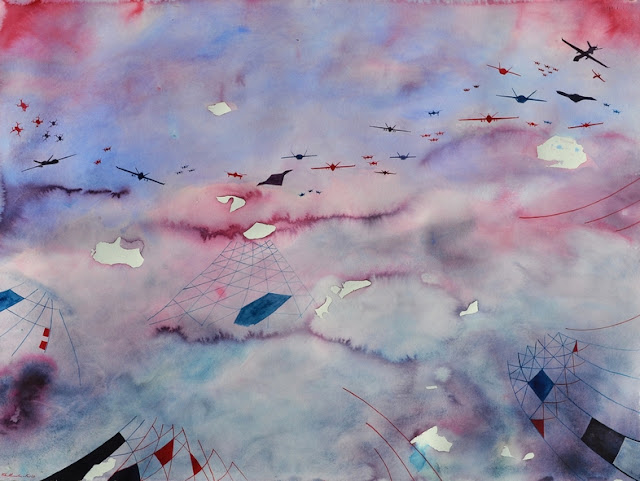
The final painting we discussed on the podcast is one of a large series of paintings entitled Theatre of War. Kathryn explains the concept here: “Theatre of War was inspired by thinking about Derek Gregory’s idea of ‘everywhere war’. If war is everywhere, then the whole world is a ‘theatre of war’. Everywhere means just that – geographical landscape, cyber and digital worlds, space and everything in-between. It can also mean time. This is possible if you think of everwhere as being about space/place as well as time/history.
Readers of General Carl von Clauswitz’s famous book On War will be aware that he writes consistently about the ‘theatre of war’. Written during the early nineteenth century and published posthumously by his wife in 1832, it is clear von Clauswitz’s theatre of war differs from twenty-first century ideas of war operation. For von Clauwitz the theatre of war was a defined geographical situation or place. Depending on offensive or defensive actions, landscape and topography played important roles in strategising, preparation and battle.
In the twenty-first century war has morphed beyond earthly geography and topography into discrete spaces of the cyber world, algorithms and light speed signal transmission. It has also extended into space, where orbiting satellites are now drawn into war’s network. The network helps to blur the lines between military, policing and security activities. As civilian activities collapse into militarised zones, war insidiously infiltrates everywhere. The signalic character of contemporary war operation allows for escalation or de-escalation, a war of degrees, not of a duration between declaration and end.
In Theatre of War I have set up a global stage with a sky/space backdrop. The lines painted over the landscape ‘speak’ to computer geolocating graphics. The real and virtual become one stage. In the distance an array of different types of drones act as both audience and actors. This kind of dual witnessing draws everything onto the everywhere war stage. It is a place where networked systems direct everything and everyone in tragic complicity. With war’s duration consumed by the everywhere, a curtain is no longer needed. Do not be fooled by what might seem beautiful.”
If you want to find out more, please do listen to the podcast. We hope that our discussion gets you visualising war, human history, the cosmos and its/our future in fresh and thought-provoking ways. As Kathryn urges, we should all practice a bit of imaginational metaveillance when we can!
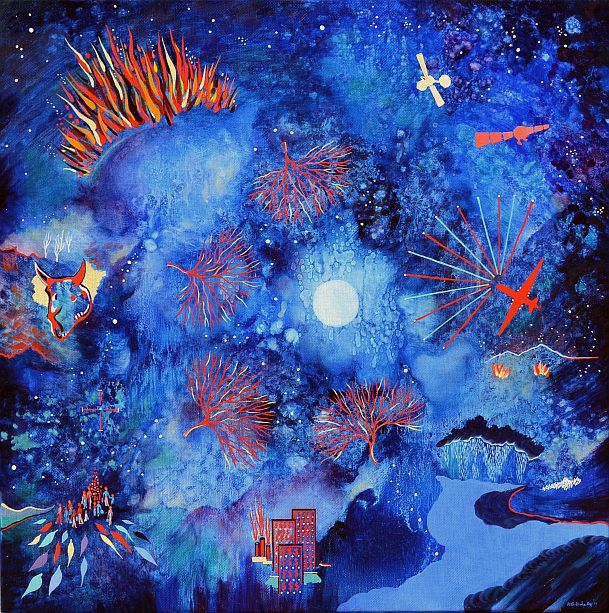
The Catastrophe of Civilisation Oil on linen 61 x 61 cm 2019 
Theatre of War: Plague Cloud Oil on linen 112 x 92 cm 2021
